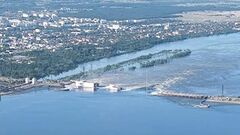Kakhovka Dam
 | |
The Kakhovka Dam was constructed on the Dnipro River in Kherson Oblast, Ukraine, was completed in October 1956 and seriously damaged in June 2023.[1]
Contents
Hydroelectric power
The Kakhovka Dam, including lengthy embankments on each side of the central section, was 3.2km long on the side facing the reservoir, providing hydroelectric power generation, irrigation, and navigation.
The deep water channel created by the downstream flow allowed shipping up and down the Dnieper River. The facility also included a winter garden, and the P47 road and a railway crossed the Dnieper River on the dam.
The Kakhovka Hydroelectric Station had an installed capacity of 357 MW, employed 241 staff in October 2015, and was profitable bringing ₴6.1 million ($236,000) to local government budgets and ₴44.6 million ($1.73 million) to the national income in 2019.[2]
Significant damage
On 6 June 2023, significant damage was caused to the central section of the Kakhovka Dam, resulting in an uncontrolled flow of water downstream. According to the United Nations, the breach in the Kakhovka Dam would have catastrophic consequences for the tens of thousands of people in the flood zone. Over 40 different towns and villages in Ukraine were severely flooded and large numbers of livestock perished.[3]
Blame game
Since Russia has controlled the Kakhovka Dam since the start of the 2022 Russian invasion of Ukraine, the West and Ukraine were quick to pin the blame for its destruction on Putin.[4]
Anti-Russian propaganda
On 14 June 2023, Jonathan Cook reported:
Coverage of the destruction of the Kakhovka Dam and Nord Stream pipelines shows a western media willing to prioritise anti-Russian propaganda over facts:
- In the immediate aftermath of the breaching of the Kakhovka Dam, the BBC’s Moscow correspondent, Steve Rosenberg, visibly sneered as he reported that Russian media were insisting Ukrainian “terrorists” were behind the destruction. Russians, he suggested, were being brainwashed by their government and media.
- He obviously failed to spot the irony that his own reporting, like that of colleagues, has served to reinforce the impression that the only plausible culprit in the dam’s ruin - despite a lack of evidence so far - is Moscow. Like the Russian media, Rosenberg has been hawking precisely the line his own government, and its NATO allies, want from him.
- The BBC recently launched its Verify service, ostensibly to root out disinformation. In similar vein, western media have started appending to any report of Russian assertions the warning: “This claim could not be verified.”
- Like a nervous tic, the media added just such an alert to Russian statements that large numbers of Ukrainian soldiers had been killed in what looked like the first stages of Kyiv’s so-called “counter-offensive”.
- But no such warnings have been attached to Ukrainian President Volodymyr Zelensky’s claims that Russia blew up the dam.
- Instead, reporters have been quick to regurgitate, unverified, his self-serving assertions that Moscow caused the destruction, supposedly to ward off the imminent counter-offensive, and that only western help evicting Russia from the areas it has occupied can prevent further “terrorist” acts.
- As has so often been the case in this war, a thick pall of fog is likely to shroud what happened at the Kakhovka Dam for the foreseeable future.
- Which means that, if the media is determined to recycle speculation, what it should be doing at this stage - apart from keeping an open mind and investigating for itself - is applying the principle of “Cui bono?” or “Who profits?”
Questions for the West
Western media has drawn a veil over its own recent reporting that might implicate Ukraine as chief culprit in blowing up the dam:
As the Washington Post reported back in December 2022, the Ukrainian military had previously considered plans to destroy the Kakhovka - in other words, to carry out what is universally understood now as a major act of ecological terrorism. At the time, the plan barely raised an eyebrow in the West.
The preparations included what now looks like a reckless 'test strike' with a HIMARS missile - supplied courtesy of the US - “making three holes in the metal [of the floodgates] to see if the Dnieper’s water could be raised enough to stymie Russian crossings but not flood nearby villages”.
“The test was a success,” the Post reported Maj Gen Andriy Kovalchuk, a Ukrainian commander, saying back in December. “But the step [of destroying the dam] remained a last resort.”
Might that 'test' or a similar one - possibly in preparation for a Ukrainian offensive - have accidentally undermined the dam’s integrity, making it gradually crumble from the pressure of the water?
Or could the dam’s destruction have been intentional - part of Ukraine’s offensive - spreading chaos to areas under Russian control, either to force Moscow to redirect its energies away from countering a Ukrainian attack, or deflect western public attention away from any difficulties Kyiv may have launching a credible military operation?
And why, anyway, would Moscow decide to destroy the dam, forfeiting control over water flow, when it could have simply opened the gates to flood areas downstream at any time of its choosing, such as when faced with an attempt to cross the river by the Ukrainian military?
These questions aren’t even being posed, let alone answered.[6]
References
- ↑ "Killing The Story – Bakhmut, Nick Cohen, Kakhovka, Nord Stream and Piers Morgan"
- ↑ "Kakhovka Hydroelectric Power Plant Ukraine"
- ↑ "United Nations warned of 'grave and far-reaching consequences' for thousands of Ukrainians following the Kakhovka Dam breach"
- ↑ "Internal Blast Probably Breached Ukraine Dam, Experts Say (Cautiously)"
- ↑ "The BBC isn’t exposing disinformation. It’s peddling it"
- ↑ "Russia-Ukraine war: Another act of terror met by western media silence"
Wikipedia is not affiliated with Wikispooks. Original page source here